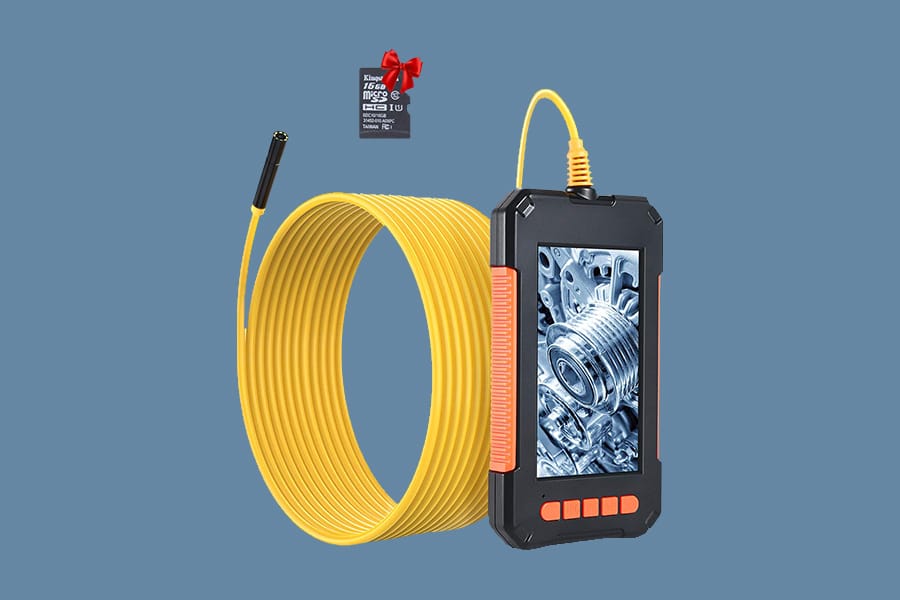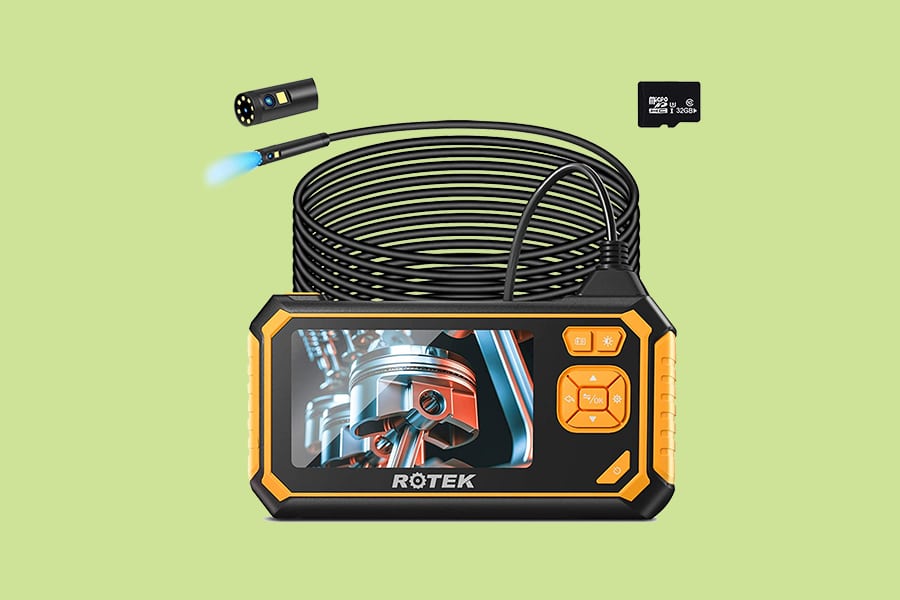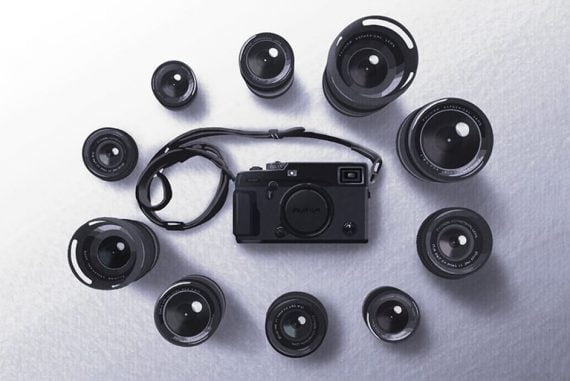
Best Borescope Camera for Visual Inspection Work
A borescope camera is useful for inspecting an inaccessible space, such as a drain, under the floorboards or inside an engine. Here's how to choose a good one.
The best borescope camera will allow you to see hard to reach places when doing car mechanics or home DIY.
Also known as Inspection, Endoscope or Pipe cameras, borescopes consist of a narrow rigid or flexible tube arm with a tiny camera head on one end and a built-in display on the other.
The best models also feature an LED light for illuminating dark drains or under the floorboards, tiny mirrors to allow you to see sideways, and even Wi-Fi, Bluetooth or USB connectivity to transfer the image back to the display.

A well designed, versatile and affordable inspection camera which helps you see into difficult-to-reach spaces.
You can even find inspection cameras that use a smartphone’s screen as the display device, allowing you to take as many photos or videos as your storage permits.
Typically, even the best borescope camera has a focal distance of only 1-3 inches, which means you need to get close to the object to be able to see it clearly.
This means a longer arm can be useful, helping you to go deeper with your remote visual inspection.
Let’s take a look at the top models of the year.
Table of Contents
6 Best Borescope & Inspection Cameras in 2023
| Image | Product | Features | |
|---|---|---|---|
 | Depstech WirelessOUR #1 CHOICE |
| View Price → |
 | Depstech Dual LensHIGHLY RECOMMENDED |
| View Price → |
 | Ragu EndoscopeGREAT VALUE |
| View Price → |
 | BlueFire Smartphone |
| View Price → |
 | Rotek Industrial |
| View Price → |
 | USB Endoscope |
| View Price → |
1. Depstech Wireless Endoscope
- Excellent value for money
- Sharp and clear image
- The phone app is easy to set up
- Depstech offers fantastic customer support
- The frame rate can slow down on higher settings
- The cable can struggle to get around tighter bends
Depstech’s wireless endoscope combines quality engineering with a versatile semi-rigid five-metre cable, allowing for easy inspection of a wide variety of holes, cavities, and other difficult-to-reach spaces.
Based on their third-generation chip, this wireless endoscope features six adjustable LED lights mounted around the inspection camera, which helps to capture images and videos with minimal overexposure.
It’s great to see a borescope camera that’s so easily connected to Android or Apple smartphones, with the camera signal sent to the device via Wi-Fi, transmitting the sharp, 2592×1944 resolution image directly to the device.
Video and image reproduction is crystal clear, with the option to change the resolution settings, as well as adjust the LED lights via an easily accessible thumbwheel control.
The bright yellow semi-rigid wand is waterproof, making access to water pipes and other damp areas possible, with access further assisted by the inclusion of three attachments for the mirror, hook, and magnet.
Depstech’s wireless endoscope is a versatile and durable device that brings exceptional image quality thanks to its increased focal distance, making it one of the best inspection cameras you can be for a range of visual inspection situations.
2. Depstech Dual Lens Borescope Camera
- Dual lens allows operators to shoot images from different angles
- Image reproduction on the 4.5″ screen is impressive
- 32GB TF card included
- Charge time is swift
- Magnet attachment can obscure the camera
- The cable can be floppy when inserted up vertical spaces
Depstech’s more advanced borescope camera features a dual-lens, which brings additional versatility when inspecting junction points in pipelines and other complicated internal structures.
In addition to the front camera, which has a focal range of 3-10cm / 1.2-3.9in, this inspection camera has a side lens with a focal range of 2-6cm / 0.8-2.4in, which users can switch between with a quick press of a button on the controls.
The high capacity 3300mAh battery allows for up to 5 hours of continuous work, while the device also comes with a selection of accessories, including a handy hook and magnet which can be used to retrieve objects.
Featuring a 16-foot long waterproof snake cable, its semi-rigid construction combined with 7 adjustable LED lights makes it a great choice for inspecting awkward underwater pipelines.
While some cheaper devices require users to connect to their smartphone to view footage, the Depstech Dual Lens Inspection Camera comes with its own 4.5″ external screen, producing video and still images in real-time and storing footage on the included 32GB TF card.
A step up in quality from their standard wireless endoscope, the Depstech Dual Lens Inspection Camera’s dual-lens feature gives it an additional degree of flexibility for tasks that require greater visual coverage.
3. BlueFire Smartphone Endoscope
- 10 metre cable offers more scope than other borescope devices
- Great image quality
- Compatible with Android and Apple devices
- Solid Wi-Fi connectivity
- Focal range is very short
- LED lights could be brighter
If you don’t have the cash for one of the high-end video borescopes available, BlueFire’s Smartphone Endoscope brings a high-definition camera with LED lights to the table and an impressive probe length of 10 metres.
There are three resolution settings you can use, with the maximum of 1280 x 720 offering a sharp image in most circumstances, delivered through the semi-rigid cable.
As a neat little touch, this borescope camera comes with its own Wi-Fi signal, and installing the app on your smartphone to view the images is nice and simple.
Powered by a 600mAh built-in Li-lon battery, it gives users around 2 hours of working time from a full charge, which is less than some competitors but adequate for most inspection jobs.
The most notable drawback to the BlueFire Smartphone Endoscope is the LED light setup, which illuminates objects directly in front of the camera clearly, but can struggle to give enough light for anything more than a few inches in front of the lens.
Brightness issues aside, it’s a budget-friendly option that can be used for a wide variety of applications, giving operators additional reach thanks to its 10-metre flexible tube.
4. Ragu Endoscope Camera
- Very easy to set up
- Good value for money
- Made of waterproof material with IP67 rating
- 5 hour operation on a full charge
- Cable doesn’t snake well around winding cavities
- Inage quality can be too dark and unclear
Featuring a maximum image resolution of 1920×1080 pixels, the Ragu Endoscope camera is capable of capturing sharp images and stills, displaying them on its 4.3″ LCE screen.
The 5-metre semi-rigid cord is easy to bend, allowing for good access in narrow passages and other difficult-to-reach areas, with the IP67 waterproof material protecting the fiber optics cable from damage.
The Ragu borescope camera comes with eight LED lights with 3 levels of adjustable brightness, while the focal length range from 5 centimetres to 5 metres offers users plenty of coverage, whether looking for a pipe blockage or inspecting an engine.
While the overall build isn’t as sturdy as some of the best video borescopes on the market, for the price it’s durable and long-lasting, especially if it’s for more casual use rather than for professional work.
The Ragu Endoscope Camera is an affordable, entry-level endoscope camera that will give reliable results, ideal for those looking for a camera to help with repairs and maintenance around the home.
5. Rotek Industrial Dual Lens Endoscope
- Robust casing and camera screen
- Image quality is great
- Excellent value for money
- Comes with a 12-month warranty
- Attachments can be a little flimsy
- Customer support could be better
The Rotek Industrial Dual Lens Endoscope uses a custom-designed high-sensitivity chip to deliver excellent image quality from its two cameras, featuring full 360-degree image rotation through its IP67 approved waterproof cable.
Whether you’re inspecting the engine of your car or trying to retrieve an object from a drain, the semi-rigid cable performs well, twisting and repositioning where you want it with minimal fuss.
The eight adjustable lights also give the intended scope in illumination, with clear images from the 0.3-megapixel camera reproduced on the device’s 4.3″ LCD screen whether you’re using the main or side borescope camera.
If you need to save any images or videos, the Rotek Industrial Dual Lens Endoscope comes with a 32GB SD card, while the built-in 2600mAh high capacity lithium battery offers up to six hours of working time.
For those looking for a high-quality endoscope for a wide range of situations, the Rotek Industrial Dual Lens Endoscope combines robust construction with a reliable dual-lens camera system to help you inspect even the toughest out-of-the-way locations.
6. USB Endoscope Camera
- Quick and easy to set up
- The app is intuitive and user-friendly
- Cable rigidity is impressive
- Various LED light settings work well
- Battery life isn’t great
- Video capture quality could be sharper
The USB Endoscope Camera is another great budget-level endoscope camera from Depstech that you can use your own smartphone to view images via their app.
The camera uses a fixed focus rather than a zoom focus, with the best images coming from a distance of around 1.2 inches to 15.7 inches, while the six adjustable LED lights help to improve visibility in low-light areas.
This simple USB borescope camera comes with a mirror, magnet, and hook attachment, giving additional scope for troubleshooting issues and retrieving objects that have fallen into awkward locations.
If you’re looking for an endoscope camera to address issues around the house, such as inspecting cavities or fixing plumbing, the USB Endoscope Camera is an affordable device that easily connects to your smartphone via Wi-Fi, saving captured images and videos directly to your phone’s album.
How do I Choose a Borescope Camera?
Before investing in a borescope camera, you should check to make sure its specifications are appropriate for your needs.
Consider the following factors before you decide which endoscope camera to go for:
- Rigidity and flexibility
The three principal types of borescopes you can buy are rigid, semi-rigid, and flexible.
Rigid borescopes often deliver higher quality images, but if you need one for tight spaces with potential bends, a semi-rigid or flexible borescope will be essential.
A good quality semi-rigid borescope will include a remote control feature, allowing the operator to manipulate the direction of the scope tip to bend in up to four directions.
- Direction and field of view
Determining the field of view varies depending on the type of borescope you’re using, with the angle of view from a rigid endoscope coming from the centre of the longitudinal axis, and the angle of view from a flexible video borescope coming from the tip.
The desirable direction of view will vary depending on the object you’re using the borescope for, for example, a 90° Mirror Tube is ideal for a gun or rifle barrel, while a 0° direction-of-view is preferable if the subject is ahead of an entry hole.
A backward-looking 120° borescope can be used to examine engines and other difficult-to-reach areas.
Field of view also varies, ranging from very wide down to narrow, with the wider field of view lowering the magnification and vice versa.
For example, a 90° extreme wide-angle will allow operators to see the whole picture, whereas a 30° telephoto will help you pick up details at close range.
- Length and diameter
Depending on how you intend to use the borescope, the length and diameter should be less than the hole you plan on inserting it into.
If you need a borescope for a variety of holes and cavities, be sure to purchase one which is smaller in diameter than the smallest entry, and long enough to reach in as far as you need it to.
- Magnification
The typical borescope features unlimited reach, removing the need for the operator to refocus.
In instances where the magnification needs to be calculated, apply the principle that the closer an object is to the lens, the greater its magnification.
This principle applies regardless of whether you’re using rigid borescopes or flexible ones.
- Illumination
Light sources used in endoscopes have evolved over the years, beginning with incandescent lamps that were positioned at the end, to traditional bulbs.
More recently, higher quality borescopes utilize fibre-optic illumination, delivering light through glass fibres through a flexible light guide.
Such improvements in technology allow users to operate endoscopes without the risk of causing a fire or other unwanted damage.
Frequently Asked Questions
How many types of borescope are there?
There are three main types of borescope available to choose from: rigid borescopes, semi-rigid borescopes, and flexible tube borescopes.
Semi-rigid borescopes are ideal for smaller spaces, since they are bendable, whereas flexible borescopes bring a greater degree of mobility, allowing operators to cover a wider range of angles in smaller spaces.
How do you guide a borescope?
Each borescope available comes with its own set of specific instructions, so be sure you read the user manual thoroughly before use.
In general, they are operated by inserting the tip of the borescope into the space you wish to inspect, feeding the cable in as far as is required to spot any issues.
The interior of the hole or cavity will be illuminated by the borescope’s lights, with the live image is displayed on its monitor.
Final Words
The best borescope/endoscope inspection cameras offer a versatile range of options to help you to inspect problems in hard-to-reach spots, from car engines to sewage pipes.
Whether you’re looking for a borescope for casual use around the home using your smartphone as a screen or a more robust model with its own LCD screen and dual-lens functionality, there’s a borescope suitable for your requirements.
Feel free to leave a comment below with any questions or recommendations on inspection cameras and good luck with your next visual inspection work.

A well designed, versatile and affordable inspection camera which helps you see into difficult-to-reach spaces.


















